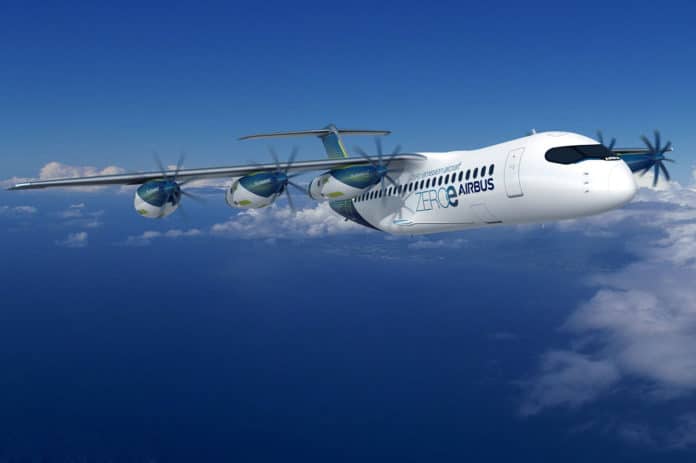Among the numerous studies that exist to find a solution for the future aircraft, this is the latest from Airbus: a new configuration as part of the ZEROe program that could enable a passenger aircraft to fly farther than ever without emissions.
The innovative approach consists of six, eight-bladed “pods” mounted beneath the aircraft wing. While the “podded” engine is not a new concept in aviation, these “pods” are not designed to be driven by any ordinary propulsion system: hydrogen fuel cells are among the key components.
Smaller experimental hydrogen aircraft, comprising up to 20 seats, can rely on a traditional fixed-wing configuration with two propellers. But more passenger capacity and longer range require another solution. This is why Airbus is studying a variety of configurations, including “pods,” to determine which option has the potential to scale up to larger aircraft.

“The ‘pod’ configuration is essentially a distributed fuel cell propulsion system that delivers thrust to the aircraft via six propulsors arranged along the wing,” explains Matthieu Thomas, ZEROe Aircraft Lead Architect. “Hydrogen fuel cells have very different design considerations, so we knew we had to come up with a unique approach.”
Each “pod” is essentially a stand-alone propeller propulsion system powered by hydrogen fuel cells. It consists of a propeller, electric motors, fuel cells, power electronics, LH2 tank, a cooling system, and a set of auxiliary equipment.
Hydrogen and air enter the fuel cells to generate electrical current, and the power electronics convert the current to power the electric motors. Thanks to this energy, the motor shaft rotates, thereby turning the propeller. Another striking feature of the pod configuration is the removable fixtures. This means that each pod can be disassembled and reassembled in record time. This approach can provide a practical and fast maintenance solution.
The eight-bladed pod propellers, made of composite materials, are shaped to provide additional thrust during takeoff and climb. The advanced airfoil design is expected to result in improved efficiency and performance.
Although advanced in its design, the “pod” configuration still requires a lot of work to determine whether it could be a suitable solution. “This ‘pod’ configuration is a great starting point to nurture further inquiry into how we can scale up hydrogen technology to commercial aircraft,” Glenn Llewellyn, VP of Zero-Emission Aircraft, explains. “This is one option, but many more will be conceptualized before we make a final selection, a decision that is expected by 2025.”
The ZEROe project has already presented other concepts showed here in September this year.
